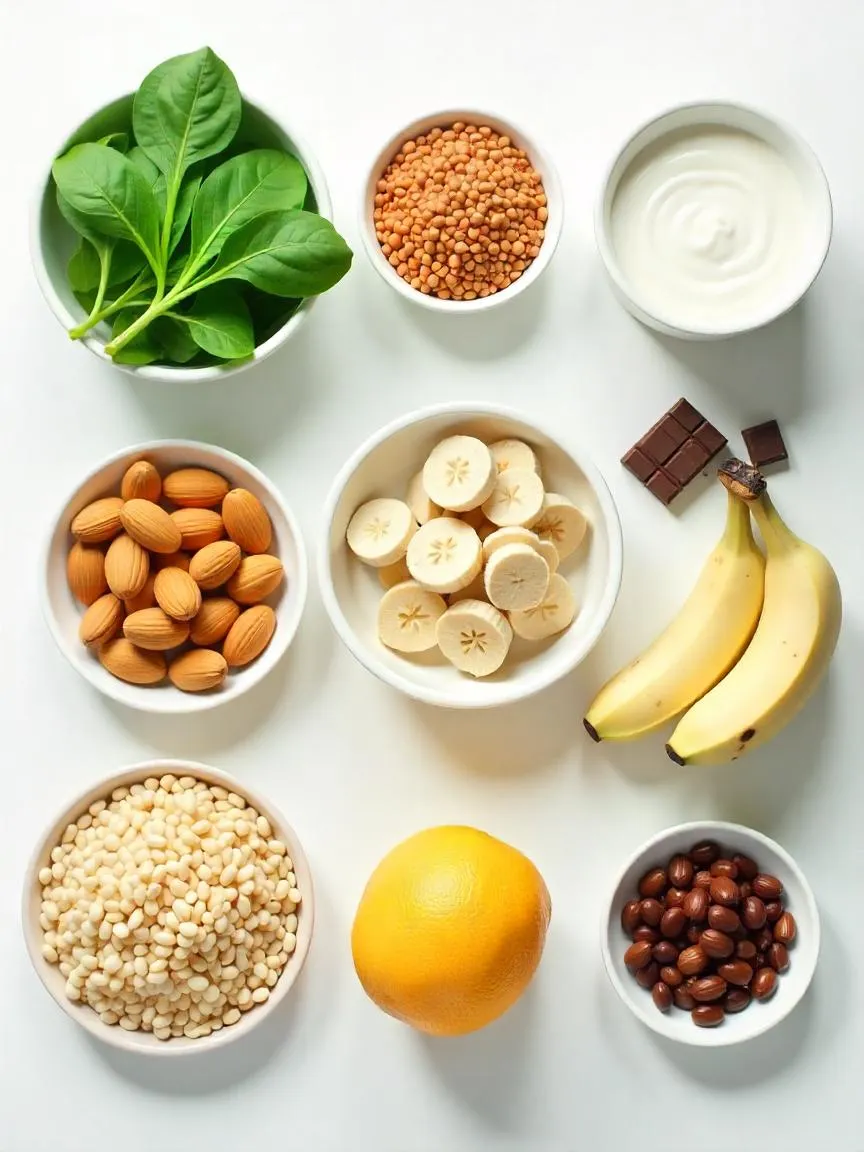Contents
Vitamins and minerals are essential micronutrients—nutrients the body needs in small amounts to function properly. They play a crucial role in everything from producing energy to healing wounds and boosting your immune system.
Unlike macronutrients (such as carbohydrates, protein, and fat), micronutrients are not made by the body, so we must get them from the foods we eat. Despite their small required amounts, deficiencies in these nutrients can lead to serious health problems.
A well-balanced diet rich in fruits, vegetables, whole grains, lean proteins, dairy, and healthy fats typically supplies all the vitamins and minerals your body needs. However, lifestyle, age, medical conditions, and dietary restrictions can influence your specific nutrient needs.
This article explores:
- The difference between vitamins and minerals
- Key types of each and their health benefits
- Signs of deficiency
- Food sources to include in your daily meals
- Whether supplements are necessary
Let’s start by understanding what these micronutrients are and why they’re so vital to your health.
🧪 Understanding Vitamins and Minerals
🔹 What Are Vitamins?
Vitamins are organic compounds your body needs to function normally. They are divided into two categories based on how they are absorbed and stored:
- Fat-Soluble Vitamins:
These vitamins dissolve in fat and are stored in the body’s fatty tissue and liver. Because they can accumulate, excess intake—especially through supplements—can lead to toxicity.- Vitamin A
- Vitamin D
- Vitamin E
- Vitamin K
- Water-Soluble Vitamins:
These dissolve in water and are not stored in the body. Instead, any excess is typically excreted in the urine. This means they must be consumed more regularly.- Vitamin C
- B-Complex Vitamins: including B6, B12, thiamin, riboflavin, niacin, biotin, pantothenic acid, and folate
🔸 What Are Minerals?
Minerals are inorganic elements found naturally in soil and water, which enter the food chain via plants and animals. They are vital for functions like bone formation, fluid balance, nerve signaling, and more.
- Major minerals: Needed in larger amounts
- Calcium
- Potassium
- Magnesium
- Sodium
- Phosphorus
- Chloride
- Sulfur
- Trace minerals: Needed in tiny amounts, but still essential
- Iron
- Zinc
- Copper
- Iodine
- Selenium
- Manganese
- Fluoride
📊 How Much Do You Need?
In the U.S., the Dietary Reference Intakes (DRIs)—developed by the National Academy of Medicine—provide recommended daily intakes for over 40 nutrients, including all essential vitamins and minerals. These guidelines vary by:
- Age
- Gender
- Life stage (e.g. pregnancy, lactation)
They’re based on extensive research into both deficiency risks and potential toxicities. For practical use, DRIs form the basis for nutrition labels and public health guidelines in both the U.S. and Canada.
Recommended Daily Intake of Vitamins
| Nutrient | RDA/AI – Women | RDA/AI – Men | Upper Limit |
| Vitamin A | 700 mcg | 900 mcg | 3,000 mcg |
| Thiamin (B1) | 1.1 mg | 1.2 mg | N/A |
| Riboflavin (B2) | 1.1 mg | 1.3 mg | N/A |
| Niacin (B3) | 14 mg | 16 mg | 35 mg |
| Pantothenic Acid (B5) | 5 mg* | 5 mg* | N/A |
| Vitamin B6 | 1.3–1.5 mg | 1.3–1.7 mg | 100 mg |
| Biotin (B7) | 30 mcg* | 30 mcg* | N/A |
| Folate (B9) | 400 mcg | 400 mcg | 1,000 mcg |
| Vitamin B12 | 2.4 mcg | 2.4 mcg | N/A |
| Vitamin C | 75 mg (+35 mg for smokers) | 90 mg (+35 mg for smokers) | 2,000 mg |
| Choline | 425 mg* | 550 mg* | 3,500 mg |
| Vitamin D | 15–20 mcg (600–800 IU) | 15–20 mcg (600–800 IU) | 100 mcg (4,000 IU) |
| Vitamin E | 15 mg | 15 mg | 1,000 mg |
| Vitamin K | 90 mcg* | 120 mcg* | N/A |
Recommended Daily Intake of Minerals
| Nutrient | RDA/AI – Women | RDA/AI – Men | Upper Limit |
| Calcium | 1,000–1,200 mg | 1,000–1,200 mg | 2,500 mg |
| Chloride | 1.8–2.3 g* | 1.8–2.3 g* | N/A |
| Chromium | 20–25 mcg* | 30–35 mcg* | N/A |
| Copper | 900 mcg | 900 mcg | 10,000 mcg |
| Fluoride | 3 mg | 4 mg | 10 mg |
| Iodine | 150 mcg | 150 mcg | 1,100 mcg |
| Iron | 8–18 mg | 8 mg | 45 mg |
| Magnesium | 310–320 mg | 400–420 mg | 350 mg (from supplements) |
| Manganese | 1.8 mg* | 2.3 mg* | 11 mg |
| Molybdenum | 45 mcg | 45 mcg | 2,000 mcg |
| Phosphorus | 700 mg | 700 mg | 3,000–4,000 mg |
| Potassium | 2,600 mg* | 3,400 mg* | N/A |
| Selenium | 55 mcg | 55 mcg | 400 mcg |
| Sodium | 1,500 mg* | 1,500 mg* | Not determined |
| Zinc | 8 mg | 11 mg | 40 mg |
💊 What About Multivitamins?
While a well-rounded diet filled with fruits, vegetables, whole grains, healthy proteins, and beneficial fats typically provides the essential nutrients your body needs, not everyone consistently meets these dietary goals. That’s where multivitamins can be helpful.
Key Points:
- Supplement, not substitute: Multivitamins are best used to fill dietary gaps, not replace real food.
- Useful in specific situations: People with restrictive diets, certain health conditions, older adults, pregnant individuals, or those with limited access to nutritious foods may benefit from supplementation.
- Not a cure-all: There’s limited evidence that multivitamins improve overall health or prevent chronic disease in well-nourished individuals.
- Quality and dosage matter: Choose reputable brands and avoid megadoses, as high levels of some vitamins and minerals can be harmful.
🔍 Learn more about when and how to take multivitamins safely, and which nutrients may be most beneficial for your age or lifestyle.
🧠 Did You Know?
The history of vitamins is rooted in medical mystery and scientific collaboration.
Since their discovery in the late 1800s and early 1900s, vitamins and their roles have sparked ongoing scientific investigation. It took epidemiologists, physicians, chemists, and physiologists working together to realize that some illnesses weren’t caused by infections or toxins—but by nutrient deficiencies.
- In 1912, Polish biochemist Casimir Funk coined the term “vitamin”, from vita (life) and amine (a nitrogen-based compound).
- Funk helped identify key nutrient deficiencies behind once-mysterious diseases:
- Scurvy (vitamin C)
- Beri-beri (vitamin B1)
- Pellagra (vitamin B3)
- Rickets (vitamin D)
By 1948, all essential vitamins had been identified, laying the foundation for modern nutritional science and disease prevention.
🧪 The Rise of Vitamin Supplements
From food to pharmacy: how vitamins became widely available.
Until the 1930s, the only way to get vitamins was through food. But as nutrition science progressed, commercially made supplements began to appear—offering isolated nutrients like vitamin C and B-complex in pill form.
📌 Public health interventions soon followed:
- Iodine was added to salt to prevent goiter.
- Folic acid was added to grains to help prevent birth defects.
- Vitamin D, known as the “sunshine vitamin,” was promoted through products like cod liver oil, famously advertised as “bottled sunshine.”
By the 1950s, multivitamins were widely sold to the public, often marketed in popular magazines with bold claims and vibrant packaging. This shift helped eliminate many deficiency diseases in industrialized nations.












Okay, so I get it, vitamins and minerals are important. Duh. But the article cuts off! What about those lifestyles that *don’t* let you eat perfectly all the time? Busy schedules, picky eaters, budget constraints… Come on, give us some real-world advice for people who aren’t Instagram food bloggers! Tell us about supplements, or at least offer some practical tips for imperfect eaters.